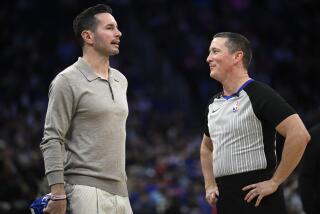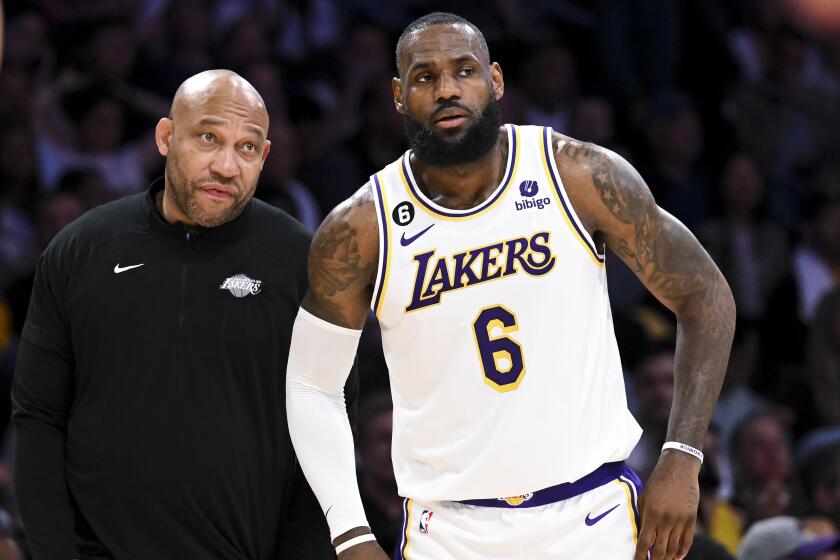PREP WEDNESDAY : Quest for Athletic Scholarships Consumes Athletes and Parents
Shad Vickers spent three years at Irvine High School, where he played varsity football for two seasons. As a sophomore, he was a starter and, as a junior, he became the team’s star.
Vickers gained 787 yards rushing and scored six touchdowns in 1989. The running back was the Vaqueros’ most valuable player and a big man on campus.
In short, Vickers had everything a young football player dreams about. In high school, football is tops and Vickers was the football hero.
In 1990, Vickers is a senior at Tustin. He is a starter, but he’s just one of several good players on the team.
Vickers wanted it this way. Sure he misses Irvine, where most of his friends live. He even attends Vaquero games when he can. But Vickers said he felt limited playing at Irvine and decided to transfer to Tustin.
What good was stardom if all it got him was a letterman’s jacket?
Like many high school athletes, a college scholarship--especially to an NCAA Division I school--has become Vickers’ goal. It is the reason he plays football and the reason he moved to his grandfather’s house in Tustin.
True, Vickers’ chances for a scholarship are not great, especially as a 5-foot-10, 155-pound running back. But he came to Tustin hoping to increase those chances by changing positions.
“At Irvine, I was a one-dimensional player,” said Vickers, now a defensive back and wide receiver. “If I stayed there, college recruiters would think of me as a running back and nothing else. I’m not big enough to play running back, but I think I can play wide receiver or defensive back. That’s the main reason I transferred.”
Vickers isn’t the first player to go to great lengths to attract college recruiters, and he won’t be the last. Players have changed schools or switched positions, and some have sought the help of private firms to further their athletic careers.
“I think there has always been an emphasis on athletic scholarships, but it seems stronger in the last couple of years,” Capistrano Valley football Coach Eric Patton said. “It seems like the average, run-of-the-mill players are talking about it more.”
Football coaches are not the only ones who have seen the interest in scholarships grow. Basketball, soccer and volleyball coaches also have seen an increase.
The quest for scholarships in girls’ sports is even more competitive, coaches say, mainly because there are fewer scholarships available.
“There are so many good girls’ athletes to choose from that you almost have to be a superstar to get a scholarship,” former Valencia softball Coach Debbie Fassel said. “I’ve noticed that players tend to feel they’re not good athletes just because no one offers them a scholarship.”
The scholarship frenzy is caused in part because of rising education costs. If a student can defray--or even eliminate--the cost of tuition, so much the better.
And if college can be paid for through athletics, it certainly can pay to play high school sports.
But the free education is only part of the motivation, coaches say.
“I think people sometimes judge a high school players’ success on whether or not a kid gets a full-ride scholarship,” Irvine football Coach Terry Henigan said. “With the money, the prestige, the publicity, a kid sometimes feels like a failure if he doesn’t get that scholarship.”
As a sophomore, Matt Spence was a starting running back at Mater Dei. The next year he transferred to Capistrano Valley, a move Spence said was motivated in part by his quest for a scholarship.
“All through high school, I dreamed about playing in front of 100,000 people,” said Spence, who plays football and baseball at Santa Clara University. “I remember when my dad took me to the USC-Notre Dame game in 1978. The Coliseum was packed and USC won the game in the final seconds. I couldn’t help but think that some day I would be on that field.”
It was easy for Spence to carry that dream through high school. He played in the same backfield as Todd Marinovich--at Mater Dei and Capistrano Valley--and recruiters seemed to be ever-present.
Spence began to receive numerous letters from universities when he was a sophomore. As a senior, he was wined and dined by recruiters. He never doubted he would sign with a school with a major program.
In the end, though, no Division I school offered him a scholarship.
“I was all pumped up by the letters and the attention,” Spence said. “Then, when it didn’t happen for me, I was devastated. Playing for a Division I school was my goal. It had been ever since I was a kid watching games with my dad.”
Parents can be part of the problem, say coaches, when they sometimes overestimate their children’s athletic ability.
Patton said he has been approached by parents, whose children are still in junior high school, who want to know what their child needs to do to earn a scholarship.
Other coaches said some parents have suggested that their sons would be better at another position, which they think he will play in college. And, sometimes, when parents don’t get their wish, the student transfers.
Fountain Valley has had 75 players receive Division I scholarships in football since 1971, ranking the Barons among the leaders in Orange County. However, that has fostered some unreasonable expectations, Coach Mike Milner said.
“Most parents are unrealistic, envisioning their son as a scholarship player in college,” Milner said. “They don’t understand the size, physical ability and athletic ability that is necessary to play college football. They think because their son played the same position as a Duval Love (Rams) or Lance Zeno (UCLA) and the team wins, his son should get a scholarship.”
At Irvine, Henigan meets with returning juniors and their parents every January, and the major topic of discussion is scholarships. Henigan said he tries to emphasize that only a small percentage of high school players receive an athletic scholarship, but sometimes his words fall on deaf ears.
“Basically, parents are telling you to, ‘Start my son, start him at the right position, make sure he’s happy, keep him drug free, keep him eligible and, by the way, make sure he gets a scholarship,’ ” Henigan said. “I’ll help any kid in that area, but it’s not really my role. They didn’t create high school football as a training ground for college football.”
Many coaches believe colleges only fan the flames with their recruiting methods.
Nearly every Division I college sends out thousands of recruiting letters each year. Mainly, the letters are an initial inquiry and usually include a questionnaire.
However, players sometimes take the recruiting letters as if they were scholarship offers.
“I got my first one last January,” Vickers said. “It was from USC. I brought it to school and showed my friends. I know letters mean almost nothing, but it’s hard to ignore them. I think Nebraska sends me something every two or three days.”
Jon Kaplan, an administrative assistant for the UCLA football team, said the Bruins send out 4,000 letters to high school juniors each year. That mailing list then is trimmed to 1,000 by the time those players are seniors.
Of those 1,000, only 90 will be invited to visit the school. And, under NCAA rules, only 25 can be offered a scholarship.
“An initial letter is basically a request for information,” USC recruiting coordinator Jack Himebauch said. “The coaches will then evaluate the kids and determine which ones they want to recruit.”
With a limited number of scholarships to offer, college recruiters have little room for error. They usually place the most emphasis on size and speed--linemen must be 6-6, 250 and running backs must have 4.5 speed.
El Toro quarterback Rob Johnson has a strong arm and a quick release. He is also 6-4, which gives him the size to play Division I football.
Almost every big-time program is courting him.
“I’m really lucky to be in the position I’m in,” Johnson said. “Getting a scholarship depends so much on things you can’t control. A lot of kids have talent and they work just as hard as me, but I’m the right size.”
The quest for athletic scholarships has become so important that some parents no longer wait around for their sons and daughters to be discovered. To get the word out, athletic resumes are being prepared--by the athletes’ families and, increasingly, by professional services that charge a fee.
Mike Sullivan, a senior running back at Sunny Hills, is using such a service. He received little attention last year despite having good speed.
So Sullivan signed with College Prospects of America, and the result has been an increase in the number of inquiries this season.
Last year, Sullivan received 10 letters from schools. This year, he has received 60 letters and a few phone calls from recruiters.
“No matter what, I will go to a four-year college, but a scholarship would be better,” Sullivan said. “Getting a scholarship has been on my mind ever since I entered high school. It’s not only the money, it’s the prestige. You get a scholarship and every one sort of looks up to you. I think every high school athlete has that dream.”
In chasing that dream, high school athletes have begun to specialize. Coaches say there are fewer three-sport athletes in the past 10 years.
In volleyball, soccer and softball, high school athletes tend to compete for club teams as well as for the high school. Because the club season usually begins at the end of the high school season, there’s little time to play more than one sport.
“All our kids know they have to play club to get a scholarship,” La Habra girls’ volleyball Coach Sandy Blumenthal said. “Recruiters come to look at players during the club season. It’s a shame, because our kids are missing out on a part of high school. But, it’s the only way to get a volleyball scholarship.”
Coaches say there are some advantages in players’ chasing the college scholarship. They say it makes a player work harder, which in turn benefits the team.
“A letter from a college can be an incentive,” Edison football Coach Dave White said. “Most kids keep the team’s goals in mind. They look at the scholarship as the goal at the end of the tunnel.”
In recent years, though, players have crowded into that tunnel.
“I have other goals, like winning the league championship and winning (the Southern Section) championship,” Vickers said. “But getting a scholarship would show that I was successful in high school.”
More to Read
Get our high school sports newsletter
Prep Rally is devoted to the SoCal high school sports experience, bringing you scores, stories and a behind-the-scenes look at what makes prep sports so popular.
You may occasionally receive promotional content from the Los Angeles Times.







